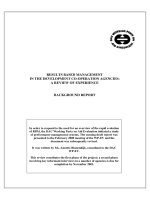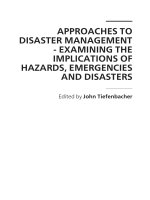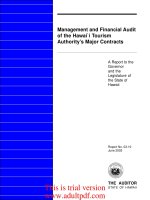Knowledge based management and the sustainability of firms
Bạn đang xem bản rút gọn của tài liệu. Xem và tải ngay bản đầy đủ của tài liệu tại đây (139.54 KB, 7 trang )
■2012 JSPS Asian CORE Program, Nagoya University and VNU University of Economics and Business
Knowledge-based management and the sustainability of firms
NGUYEN ANH THU*
Abstract :
Knowledge has been long considered a significant resource of business management. The organizations and firms can
ensure their sustainable development only by effectively managing, harnessing and also creating their knowledge
resources. Knowledge-based management theory developed by Nonaka explains and analyses the process of knowledge
creation in a firm or an organization. The theory has been highly appreciated worldwide and proved to be an effective
model for Asian countries. Many studies have shown the success application of this theory in Japanese firms and in firms
of some other Asian countries. The success of those firms rooted from the ability to enable the spiral of knowledge
creation, and by this flow, the firms can ensure its sustainable development. This paper’s objective is to provide an insight
into the link between knowledge-based management and the sustainable development of firms by analysing the success
of some Japanese as well as Vietnamese companies. The paper found that, knowledge-based management is a good way
for firms and organizations to enhance their positions in the competitive markets and to ensure their sustainable
development in the future.
Keywords : Knowledge based management, Nonaka, sustainability, firms.
1.
Introduction
can ensure its long-term development. Although many
studies have shown the success application of
Knowledge-based management theory developed by
Nonaka is a relatively new theory, however, it has been
highly appreciated worldwide and proved to be an
effective model for Asian countries. The theory rooted
from the culture of almost all Asian countries, where
high-context culture dominates, and synthesizes Asian
traditions with Western management theories. It seems
knowledge-based management theory in Asian firms,
the link between knowledge-based management and
the sustainable development of firms has yet to be
studied. This paper, therefore, will analyse the success
of some Japanese as well as Vietnamese companies to
fill in this gap. The paper aims at addressing the
following questions:
that knowledge-based management is quite close to
sustainable management, since knowledge is vital for
any firm that strive for long-term development. If the
firms can enable the spiral of knowledge creation, they
- What are the contributions of each component
of knowledge creating firm to the firm
sustainability?
*University of Economics and Business, Vietnam National University, Hanoi
- How a knowledge creating firm can achieve
sustainability?
created and exchanged within a group. Through the
Combination stage, explicit knowledge in different
- Is knowledge-based management a good way to
achieve firm sustainability?
forms is collected from many sources and combined,
edited or even processed to become a more complex
In the following section, the study will provide brief
concepts of knowledge-based management theory and
corporate sustainability. The third part then analyze the
cases and the fourth part comes up with the conclusion.
and systematic set of explicit knowledge. This complex
and systematic form of tacit knowledge is then
disseminated among the members of the organization.
At this stage, it should be applied in practical situation
so that it can be converted and internalized as
2.
Theoretical Framework
2.1.
Knowledge-based management theory
embodied and tacit knowledge of individual. This last
stage, therefore, has the name Internalization process.
Knowledge has become extremely important factor of
Knowledge then continues its spiral of knowledge
resources of the modern knowledge-based economies,
creation by the conversion of tacit and explicit
beside the traditional resources, namely land, capital
knowledge following other SECI process.
and labor (Drucker, 1993). Firstly, knowledge
management was realized in the form of investment on
research and development (R&D) activities (Mansfield,
1968). Gradually, knowledge management theories
have been developed, of which knowledge-based
management theory, developed by Nonaka in 1990s, is
a relatively new theory in the field of management. The
theory provides an insight into the knowledge-creating
process, specifically the process in which an
organization creates and utilizes knowledge.
The theory found that knowledge is created and
transformed
from
tacit
knowledge
through
knowledge
a
SECI
to
explicit
Figure 1 - SECI process (adapted from Nonaka et
al., 2008)
(Socialization,
Externalization, Combination and Internalization)
process (Nonaka, 1994; Nonaka and Takeuchi, 1995).
SECI model explains the knowledge creation by
“continuous process of conversion between subjective,
tacit knowledge and objective, explicit knowledge”
(Nonaka and Toyama, 2000a).
In order to enable the SECI process in a firm, the firm
should be a knowledge-creating entity (Nonaka et al.,
2000b) or organization’s collective strengths should be
utilized (Teece, 2007). Knowledge-creating entity/firm
requires seven components, namely knowledge vision,
driving objectives, dialogue, practice, ba, knowledge
The SECI process can start at the Socialization stage,
assets and environment/eco-system of knowledge
where tacit knowledge created and shared through
(Nonaka and Toyama, 2005).
day-to-day
social
interaction.
Then
at
the
Knowledge vision and Driving objective
Externalization stage, tacit knowledge becomes
explicit in the form of concepts, images, models,
written documents or other expressions, which are
Knowledge vision and driving objectives give the
directions for the knowledge creating process of the
organizations. Knowledge vision defined the kind of
Sustainable development has three "interdependent
future that the firm imagines for itself or the overall
and mutually reinforcing pillars", which are economic
goal of the firm in the long run (Nonaka et al, 2008).
development, social development and environmental
Driving objectives are the concrete concepts, goals or
protection (WHO, 2005). These three aspects of
mission standards that help the firm to realize its
sustainable development should not be considered
vision.
separately but should be studied as constituent parts
Ba, dialogues and practices
As defined in Professor Nonaka’s theory, “ba” is the
point where dialectical dialogues and practices take
place to implement the vision and the objective of the
project (Nonaka et al, 2000a). Dialogues are the
synthesis of thought and practices are the synthesis of
forming sustainable development at their confluence
(Adams, 2006).
Sustainable development is not only the concern of
countries in the world but is also the main concern of
firms (Welford, 2000). The definition of corporate/firm
sustainability has the same dimensions, which are
action, which are conducted in “ba” to enable the SECI
economic sustainability, environmental and social
process of knowledge creation. “Ba” includes
sustainability (Figure 2).
organizational structure of the organization itself and
Economic
other shared-base and gatherings such as meetings,
Sustainability
circulation of information, public-private relations and
so on.
Knowledge assets
Knowledge assets include the knowledge already
created, such as technologies, training material; and
Environmental
Social
organizational capability to innovate, such as pattern,
Sustainability
Sustainability
way of doing things, manuals of procedures.
Knowledge assets are the outputs of a SECI process
then are the inputs of further SECI-knowledge creating
process.
Ecosystem of knowledge
The last component of the knowledge-creating entity is
environment or ecosystem of knowledge, which is
constituted of multilayered “ba” existing across
organizational boundaries. In a knowledge-creating
entity, ecosystem of knowledge plays an important
role.
Figure 2. Three dimensions of corporate sustainability
(Adapted from Dyllick and Hokerts, 2002)
Dyllick and Hokerts, 2002 has pointed out that, in
order to achieve sustainable development, the firm
should integrate three dimensions of sustainability in a
“triple-bottom line”, which are inter-related and should
be simultaneously satisfied. Sustainability also requires
integrating short tem and long-term aspects of
development.
The
last
requirement
for
firm
sustainability is consuming the income, not the capital.
The capital here is defined as not only economic
2.2. Corporate sustainability
The concept “sustainable development” has become
capital but also natural and social capital.
3. Main findings
popular over the last decades. As defined in United
Nations 2005 World Summit Outcome Document,
3.1. Vision, driving objectives and firm sustainability
As vision is the image in the future that the firm wants
the objective of the company to emphasize and
to create, it reflects the firm’s value of truth, goodness
encourage R&D innovation at every level of
and beauty. A good vision and driving objectives that
production to provide customers with green products
can be shared between all employees will motivate and
that are friendly with nature and customers.
contribute to the firm’s long-term development.
This vision of Sannam incorporates its corporate social
Eisai Co. Ltd is a Japanese mid-size pharmaceutical
responsibility,
firm, which is innovative and globally competitive.
sustainability and environmental sustainability. One
Eisai’s success was rooted from its philosophy and
typical activity of Sannam is to encourage R&D
human-centered management.
innovations to find new kind of vegetables and dried
The firm stated its mission as “Commitment to
foods for human consumption to provide consumers
Innovation”: the firm considered patients and their
with reliably safe and clean vegetables and dried food.
families as the most important participants in the
health-care process, and the firm does its best for the
benefits of these participants. Eisai, therefore, set its
vision as a “human health care” (hhc) organization
focusing on the patients and their families (Nonaka et
al., 2008). Eisai’s vision reflects its social obligation:
do the best for the patients. All of the driving objectives
of Eisai are set to realize the hhc vision rather than to
trying
to
achieve
both
social
This activity has resulted in many kinds of new brands
of Sannam, which quickly became popular in
Vietnamese market. One evidence of the R&D
innovation
and
friendly-in-life
product
is
the
development of the product Nuitan Apricot Liquor,
which is made by fresh apricots, that are found to be
rich in many useful vitamins and minerals (JICA,
2011).
increase sales, market share or profits. However, the
Eisai’s vision includes two important dimension of
results that Eisai received were higher market share
sustainable development, namely social sustainability
and higher profits. All employees of Eisai understand
and economic sustainability. Sannam’s vision includes
and follow the vision of the company in their daily jobs.
all dimensions of sustainability. These successful
Innovations, therefore, are made for the final objective
stories show that a good vision of a company should
of satisfying customers-patients.
not focus on economic indicators such as market share,
Sannam group, Vietnam was founded in 1994 with the
core products such as food, drink, machinery and
industrial equipment. Sannam has grown from a small
company with 5 staff in 1994 to a group of more than
200 staffs working in 13 member companies in 2010.
Sannam is a relatively young successful company in
Vietnam. Its success is reflected in the unique products,
technological development process and good business
strategy.
sales and profits but should look forward to a longer
term of development – the value of the common good.
Sales and profits, though not the goals, will be the
results of the process to realize the firm’s long-term
vision.
3.2. Dialogue and Practice in “Ba”
Seven-eleven Japan set up its first store in 1974, under
the license of The Southland Corporation from the
USA. Although Seven-eleven was originated from the
Long term business strategy of Sannam is driven by
USA, Seven-eleven Japan Co., Ltd has to establish
the company’s two philosophical principles, which are
itself in Japanese market, which is quite different with
“Innovative in Business” and “Friendly in Life”. These
the US market. Among the retail store companies in
two principles are inter-related and combined to reach
Japan, Seven-eleven has proved to be the most
successful one. In 2007, its profits-to-sales ratio was
picnics, conferences, learning courses, festivals and so
32%, much higher than that of its competitors Lawson
on (JICA, 2011).
and Family Mart, which are 17% and 14%,
The learning forums are typical “ba” of Gami group. It
respectively (JICA, 2009).
is a place for all Gami group’s members to exchange
The success of Seven-eleven was rooted from its
their knowledge and professional experiences. This is a
ability to enable the knowledge dialogue and practice
good “ba” for knowledge creation, where the SECI
in different forms of “ba”. The “ba” of Seven-eleven
process is facilitated.
includes managers meetings, the business reforms
meetings, the fields counselors meetings, field
counselors visits to the stores, store-staffs meetings and
especially, its point-of-sale (POS) information system.
The meetings of the operating council of Gami group,
which are organized every month, are also the
successful ba of Gami group. At these meetings, all
people of council will discuss and assess the business
Field counselors’ visits to store are important link
activities and then draw out experiences and to give
between stores and headquarters. Each field counselor
solutions for the difficulties arisen. The participants of
is assigned eight to ten stores and has to visit each store
general conferences of the operating council include
twice a week. The field counselors not only give the
the leaders of Gami group, executive directors of
stores managerial guidance such as ordering, policies,
subsidiary companies and the middle – managers. At
sale campaigns, new products, but also introduce
the meetings, participants freely express their opinions
successful experiences of other stores, provide
related to the operation, schedules as well as strategy of
technical and other support to the store management.
Gami group.
POS is confirmed to be one important factor
Seven-eleven and Gami cases prove the importance of
contributing to Seven-eleven’s success. This system
creating
can be considered a good “ba” of information
knowledge-creating entity. These “ba” ensure the
gathering and sharing. The local staffs participate in
participation of all the members of the organization
this system by their daily observations of local
into its operation and management, thus ensures the
customers behaviors, then build the hypothesis for the
long-term
demand, trial-and-error analyze this demand. The
Furthermore, “ba” is an enabling context for
information then collected to higher level and
knowledge creation, thus facilitating good “ba” will
converted into new marketing ideas. This kind of “ba”
help the organization accumulate more and more
enables the contribution of every employee as well as
knowledge, which is vital for sustainable development
facilitates the spiral of knowledge creation in the
as well.
company.
Gami group was established in 1993 in Vietnam, and
now has been developing rapidly to become a business
group operating in three main business sectors
and
energizing
development
of
“ba”
the
in
any
organization.
3.3. Knowledge assets
In this section, we would like to analyze two successful
cases of utilizing knowledge assets, which are YKK
Corporation, Japan and Alphannam Group, Vietnam.
including trade, land and franchise. The Board of
Directors of Gami group created many different forms
of “ba”, where the knowledge creation process (SECI)
takes place. These ba was under the forms of meetings,
YKK is a world leading fastener company, with
accounts for 45% of the world market share of
fasteners in 2007 (Nonaka et al., 2008). The important
reasons for YKK’s success are its ability to effectively
processing dynamic knowledge assets, namely the
cumulative technologies, human resources of the
Machinery and Engineering group and the practice of
listening to the customers. YKK ensures high quality of
all of its products because all of the production
machines were produced by YKK itself. The
cumulative technologies and innovations of YKK were
achieved by superior human resources. They work and
share their knowledge continuously in everyday job for
productivity.
Above two cases shows the experiences of firms to
facilitate tacit knowledge sharing in the firms to enable
further creation of dynamic knowledge assets. These
knowledge assets will not only benefit the firms in the
short term by reducing expenses and increasing labor
productivity but also in the long run by accumulating
technologies, building superior human resources for
the future development.
further improvement of the products. All of the
improvements made are for the benefits of the
4. Conclusion
customers. All of the YKK’s employees understand the
As the Nonaka’s theory argues, any knowledge
philosophy “customer first” and continuously pursuit
creating entity should have seven components:
this philosophy in their work.
knowledge vision, driving objectives, dialogues,
Alphanam Group was established in 1995 with initial
ten staffs. After 17 years of development, Alphanam
has become the leading provider in industrial
manufacturing
construction
and
and
installation,
infrastructure
transportation
development
in
Vietnam with 1,500 employees (JICA, 2011).
Especially, Alphanam is the leading national paint
practices, “ba”, knowledge assets and ecosystem of
knowledge. Each component plays important role in
the success of knowledge-creating firms. The study has
shown contribution of each component to the
sustainable development of firms. Vision and driving
objectives can lead the firm to long-term success only
if they convey the social and/or environmental
dimensions of sustainability besides the dimension of
provider in Vietnam.
Alphanam’s success is originated from its ability to
encourage knowledge assets creation within the
corporation. The leaders of Alphanam pay great
economic sustainability. “Ba”, dialogue and practice
ensure the participation of all the members of the
organization into its knowledge creating process, thus
ensures the long-term development of the organization.
attention on the Research and Development (R&D)
Furthermore, “ba” is an enabling context for
Department, with the task of searching ways to
knowledge creation, thus facilitating good “ba” will
improve current products and services, researching and
developing new products and services. The R&D
policy gives the rights of free creativeness to every
help the organization accumulate more and more
knowledge assets, which are vital for sustainable
development as well.
employee. Tacit knowledge and experience of
employees, therefore, are effectively utilized to create
new technologies and products. The leaders of the
Corporation view that failed experiments are not
failures but are the lessons for future innovations. With
this kind of encouragement, Alphanam’s employees
have made number of technical innovations, which can
be effectively applied in manufacturing, reducing
manufacturing
expenses
and
increasing
labor
In conclusion, the analysis of this study shows that
knowledge-based management is a good way, driving
firms and organizations to sustainability. This
confirmation leads to suggestions of further studies on
the application of knowledge-based management in the
context of Vietnam, since Nonaka’s theory is still not
thoroughly understood in Vietnam.
of the firm,” Industrial and Corporate Change, Vol. 9, No. 1,
Reference
Adams, W.M. (2006), "The Future of Sustainability:
pp. 1-20.
the
Teece, D. J. (2007), “Explicating dynamic capabilities: the
Twenty-first Century”, Report of the IUCN Renowned
nature and micro-foundations of (sustainable) enterprise
Thinkers Meeting, 29–31 January.
performance,” Strategic Management Journal, Vol. 28, No.
Re-thinking
Environment
and
Development
in
Drucker, P. F. (1993), Post-Capitalist Society, New York,
13, pp. 139-150.
NY: Harper Business.
Welford, R. (2000), Corporate Environmental Management
Dyllick, T. and Hokerts, K. (2002), “Beyond the business
3–Toward Sustainable Development, London, Earthscan.
case for corporate sustainability”, Business Strategy and the
World Health Organization (2005), 2005 World Summit Outcome
Environment; Vol. 11, No. 2, pp.130-141.
Document, 15 September.
Hall, E. T. (1976), Beyond Culture, New York: Doubleday.
JICA (2009), Textbook for the Country Focused Training
Course in Study Tour on Strengthening Organizational
Management.
JICA (2011), The Study on Knowledge Based Management
Theory in Vietnam, Project report.
Mansfield, E. (1968), Industrial Research and Technological
Innovation, New York: WW Norton.
Nonaka, I. (1994), “A dynamic theory of organizational
knowledge creation,” Organization Science, Vol. 5. No. 1, pp.
14-37.
Nonaka, I. and Takeuchi, H. (1995), The Knowledge
Creating Company, New York, NY: Oxford University Press.
Nonaka, I. and Toyama, R. (2005), “The theory of the
knowledge-creating firm: subjectivity, objectivity and
synthesis,” Industrial and Corporate Change, Vol. 14, No. 3,
pp. 419-436.
Nonaka, I., Toyama, R. and Hirata, T. (2008), Managing
Flow: a Process Theory of the Knowledge-Based Firm,
Palgrave Macmillan.
Nonaka, I., Toyama, R. and Konno, N. (2000a), “SECI, Ba
and leadership: a unified model of dynamic knowledge
creation,” Long Range Planning, Vol. 33, pp. 1-31.
Nonaka, I., Toyama, R. and Nagata, A. (2000b), “A firm as a
knowledge creating entity: a new perspective on the theory









